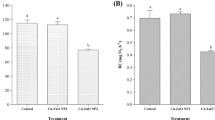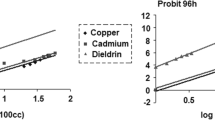Abstract
The present research work was designed to study mussel’s (Mytilus galloprovincialis) digestive gland biotransformation and detoxification responses to benzo[a]pyrene (B[a]P) exposure along with heat stress. Mussels were exposed to a sublethal dose of B[a]P [75 nM (19 μg/L/animal)] + temperature gradient (18, 20, 22, 24 and 26 °C) for 7 days. B[a]P hydroxylase (BPH) and glutathione-S-transferase (GST) activities were assessed in digestive gland tissues as phase I and phase II biotransformation parameters. Catalase (CAT) activity and malonedialdehyde (MDA) were measured as potential biomarkers of oxidative stress and lipid peroxidation. The cholinergic system was evaluated using acetylcholinesterase (AChE) activity. DNA damage was assessed using micronuclei (MN) test. BPH and GST activities showed a decreasing trend in B[a]P-exposed animals at 24 and 26 °C. CAT activity showed a bell-shaped response in B[a]P-exposed and in heat-stressed organisms at a maximum temperature of 22 °C. AChE activity was significantly inhibited in response to B[a]P being more pronounced at a temperature of 26 °C. MN in digestive gland cells suggest that B[a]P exposure induced significant DNA alteration with a maximum response in organisms coexposed to B[a]P and a temperature of 26 °C. Biomarker data are further discussed in relation B[a]P accumulation in mussels digestive gland. These data should be carefully considered in view of the biological effects of organic pollutants, particularly in organisms under the challenging effects of extreme temperature fluctuations.





Similar content being viewed by others
References
Akcha F, Izuel C, Venier P, Budzinski H, Burgeot T, Narbonne J-F (2000) Enzymatic biomarker measurement and study of DNA adduct formation in benzo[a]pyrene-contaminated mussels, Mytilus galloprovincialis. Aquat Toxicol 49:269–287
Altenburger R, Segner H, Van der Oost R (2003) Biomarkers and PAH prospects for the assessment of exposure and effects in aquatic systems. In: Douben PET (ed) PAHs: an ecotoxicological perspective. Wiley, Chichester, pp 147–171
Banni M, Jebali J, Daubez M, Clerandeaux C, Guerbej H, Narbonne JF et al (2005) Monitoring pollution in Tunisian coasts: application of a classification scale based on biochemical markers. Biomarkers 10(2–3):105–116
Banni M, Dondero F, Jebali J, Guerbej H, Boussetta H, Viarengo A (2007) Assessment of heavy metal contamination using real time PCR analysis of mussel metallothionein mt10 and mt20 expression: a validation along the Tunisian coasts. Biomarkers 12(4):369–383
Banni M, Negri A, Rebelo M, Rapallo F, Boussetta H, Viarengo A et al (2009) Expression analysis of the molluscan p53 protein family mRNA in mussels (Mytilus spp.) exposed to organic contaminants. Comp Biochem Physiol C 149(3):414–418
Banni M, Negri A, Dagnino A, Jebali J, Ameur S, Boussetta H (2010) Acute effects of benzo[a]pyrene on digestive gland enzymatic biomarkers and DNA damage on mussel Mytilus galloprovincialis. Ecotoxicol Environ Saf 73(5):842–848
Banni M, Negri A, Mignone F, Boussetta H, Viarengo A, Dondero F (2011) Gene expression rhythms in the mussel Mytilus galloprovincialis (Lam.) across an annual cycle. PLoS One 6(5):e18904
Baumard P, Budzinski H (1997) Internal standard quantification method and gas chromatography–mass spectrometry (GC–MS): a reliable tool for polycyclic aromatic hydrocarbon (PAH) quantification in natural matrices. Analusis 25:246–252
Bolognesi C, Landini E, Roggieri P, Fabbri R, Viarengo A (1999) Genotoxicity biomarkers in the assessment of heavy metal effects in mussels: experimental studies. Environ Mol Mutagen 33(4):287–292
Bradford MM (1979) A rapid and sensitive method for the quantification of microgram of protein utilizing the principal of protein-dye binding. Anal Biochem 72:248–254
Buege JA, Aust SD (1978) Microsomal lipid peroxidation. Methods Enzymol 52:302–310
Byrne M (2012) Global change ecotoxicology: Identification of early life history bottlenecks in marine invertebrates, variable species responses and variable experimental approaches. Mar Environ Res 76:3–15
Cebrian E, Uriz MJ, Garrabou J, Ballesteros E (2011) Sponge mass mortalities in a warming Mediterranean Sea: are cyanobacteria-harboring species worse off? PLoS One 6(6):e20211
Chen B, Xuan X, Zhu L, Wang J, Gao Y, Yang K, Shen X et al (2004) Distributions of polycyclic aromatic hydrocarbons in surface waters, sediments and soils of Hangzhou City, China. Water Res 38:3558–3568
Clairbone A (1985) Catalase activity. Handbook of methods for oxygen radical research. CRC Press, Boca Raton, pp 283–284
Dimitriadis VK, Gougoula C, Anestis A, Pörtner HO, Michaelidis B (2012) Monitoring the biochemical and cellular responses of marine bivalves during thermal stress by using biomarkers. Mar Environ Res 73:70–77
Dondero F, Piacentini L, Banni M, Rebelo M, Burlando B, Viarengo A (2003) Quantitative PCR analysis of two molluscan metallothionein genes unveils differential expression and regulation. Gene 345(2):259–270
Ellman GL, Courtney KO, Andres V, Featherstone RM (1961) A new and rapid colorimetric determination of acetylcholinesterase activity. Biochem Pharmacol 7:88–95
Farcy E, Voiseux C, Lebel JM, Fiévet B (2009) Transcriptional expression levels of cell stress marker genes in the Pacific oyster Crassostrea gigas exposed to acute thermal stress. Cell Stress Chaperones 14(4):371–380
Fitzpatrick PJ, Sheehan D, Livingstone DR (1995) Studies on isoenzymes of glutathione S-transferase in the digestive gland of Mytilus galloprovincialis with exposure to pollution. Mar Environ Res 39:241–244
Fitzpatrick PJ, O’Halloran J, Sheehan D, Walsh AR (1997) Assessment of a glutathione S-transferase and related proteins in the gill and digestive gland of Mytilus edulis (L.) as potential organic pollution biomarkers. Biomarkers 2:51–56
Greco L, Pellerin J, Capri E, Garnerot F, Louis S, Fournier M et al (2011) Physiological effects of temperature and a herbicide mixture on the soft-shell clam Mya arenaria (Mollusca, Bivalvia). Environ Toxicol Chem 30(1):132–141
Habig W, Pabst M, Jakoby W (1974) Glutathione S-transferases. The first enzymatic step in mercapturic acid formation. J Biol Chem 249(22):7130–7139
Jolliffe IT (1986) Principal component analysis. Springer, New York
Kefaloyianni E, Gourgou E, Ferle V, Kotsakis E, Gaitanaki C, Beis I (2005) Acute thermal stress and various heavy metals induce tissue-specific pro- or anti-apoptotic events via the p38-MAPK signal transduction pathway in Mytilus galloprovincialis (Lam.). J Exp Biol 208(23):4427–4436
Lockwood BL, Sanders JG, Somero GN (2010) Transcriptomic responses to heat stress in invasive and native blue mussels (genus Mytilus): molecular correlates of invasive success. J Exp Biol 15(213):3548–3558
Martinez PG, Livingstone DR (1995) Benzo[a]pyrenedione stimulated oxyradical production by microsomes of digestive gland of the common mussel, Mytilus edulis L. Mar Environ Res 39:185–189
Mendes R, Cardoso C, Pestana C (2009) Measurement of malondialdehyde in fish: a comparison study between HPLC methods and the traditional spectrophotometric test. Food Chem 112:1038–1045
Michel XR, Suteau P, Robertson LW, Narbonne JF (1993) Effects of benzo(a)pyrene, 3,3′, 4,4′-tetrachlorobiphenyl and 2,2′, 4,4′, 5,5′-hexachlorobiphenyl on the xenobiotic-metabolizing enzymes in the mussel (Mytilus galloprovincialis). Aquat Toxicol 27:335–344
Michel XR, Beasse C, Narbonne JF (1995) In vivo metabolism of benzo(a)pyrene in the mussel, Mytilus galloprovincialis. Arch Environ Contam Toxicol 28:215–222
Narbonne JF, Daubeze M, Clérandeau C, Garrigues P (1999) Scale of classification based on biochemical markers in mussels: application to pollution monitoring in European coasts. Biomarkers 4:415–424
Osborne MR, Jacobs S, Harvery RG, Brookes P (1981) Minor products from the reaction of benzo[a]pyreneanti-diol epoxide with DNA. Carcinogenesis 2:553–558
Phillips H (1983) Fifty years of benzo[a]pyrene. Nature 303:468–472
Quilliam MA, Hardsta WR, Anacleto JF, Leblanc MD, Stergiopoulos V, Dick KL et al (1994) Preparation and certification of solutions of perdeuterated polycyclic aromatic compounds intended for use as surrogate internal standards. Fresenius J Anal Chem 350:109–118
Shaw GR, Connell DW (1994) Prediction and monitoring of the carcinogenicity of polycyclic aromatic compounds (PAC). Rev Environ Contam Toxicol 135:1–62
Snyder MJ (2000) Cytochrome P450 enzymes in aquatic invertebrate: recent advances and future directions. Aquat Toxicol 48:529–547
Sokolova IM (2004) Cadmium effects on mitochondrial function are enhanced by elevated temperatures in a marine poikilotherm, Crassostrea virginica Gmelin (Bivalvia: Ostreidae). J Exp Biol 207:2639–2648
Sole M, Livingstone DR (2005) Components of the cytochrome P450-dependent monooxygenase system and FNADPH-independent benzo[a]pyrene hydroxylase activity in a wide range of marine invertebrate species. Comp Biochem Physiol C 141:20–31
Stegeman JJ, Hahn ME (1994) Biochemistry and molecular biology of monoxygenases: current perspectives on forms, functions and regulation of cytochrome P450 in aquatic species. In: Malins DC, Ostrander GK (eds) Aquatic toxicology: molecular, biochemical and cellular perspectives. CRC/Lewis, Boca Raton, pp 87–206
Sylvestre F, Linares-Casenave J, Doroshov SI, Kültz DA (2010) Proteomic analysis of green and white sturgeon larvae exposed to heat stress and selenium. Sci Total Environ 408(16):3176–3188
Tomanek L, Zuzow MJ (2010) The proteomic response of the mussel congeners Mytilus galloprovincialis and M. trossulus to acute heat stress: implications for thermal tolerance limits and metabolic costs of thermal stress. J Exp Biol 213(20):3559–3574
Verlecar XN, Jena KB, Chainy GB (2007) Biochemical markers of oxidative stress in Perna viridis exposed to mercury and temperature. Chem Biol Interact 167(3):219–226
Viarengo A, Burlando B, Cavaletto M, Marchi B, Ponzano E, Blasco J (1999) Role of metallothionein against oxidative stress in the mussel Mytilus galloprovincialis. Am J Physiol 277(6 Pt 2):R1612–R1619
Viarengo A, Lowe D, Bolognesi C, Fabbri E, Koehler A (2007) The use of biomarkers in biomonitoring: a 2-tier approach assessing the level of pollutant induced stress syndrome in sentinel organisms. Comp Biochem Physiol C 146(3):281–300
Volodkovich YL, Belyaeva OL (1992) Distribution of benzo(a)pyrene and other polycyclic aromatic hydrocarbons. In: Nagel PA (ed) Results of the third joint US–USSR Bering and Chukchi Seas expedition (BERPAC), summer 1988. United States Fish and Wildlife Service, Washington, DC, pp 308–313
Widdows J, Donkin P, Staff FJ, Matthiessen P, Law RJ, Allen YT et al (2002) Measurement of stress effects (scope for growth) and contaminant levels in mussels (Mytilus edulis) collected from the Irish Sea. Mar Environ Res 53(4):327–356
Acknowledgments
This work was supported by funds from Ministère de l’Enseignement Supérieur et de la Recherche Scientifique (Grant No. UR04A6R05), Biochimie et Toxicologie Environnementale, and Theme 6 of the EC Seventh Framework Program through the Marine Ecosystem Evolution in a Changing Environment Collaborative Project (Grant No. MEECE 212085).
Author information
Authors and Affiliations
Corresponding author
Rights and permissions
About this article
Cite this article
Kamel, N., Attig, H., Dagnino, A. et al. Increased Temperatures Affect Oxidative Stress Markers and Detoxification Response to Benzo[a]Pyrene Exposure in Mussel Mytilus galloprovincialis . Arch Environ Contam Toxicol 63, 534–543 (2012). https://doi.org/10.1007/s00244-012-9790-3
Received:
Accepted:
Published:
Issue Date:
DOI: https://doi.org/10.1007/s00244-012-9790-3




